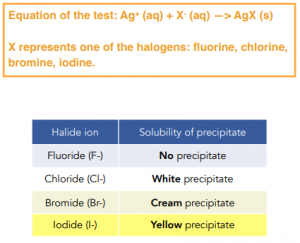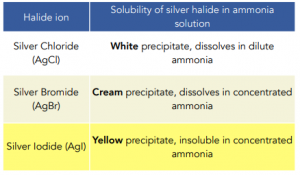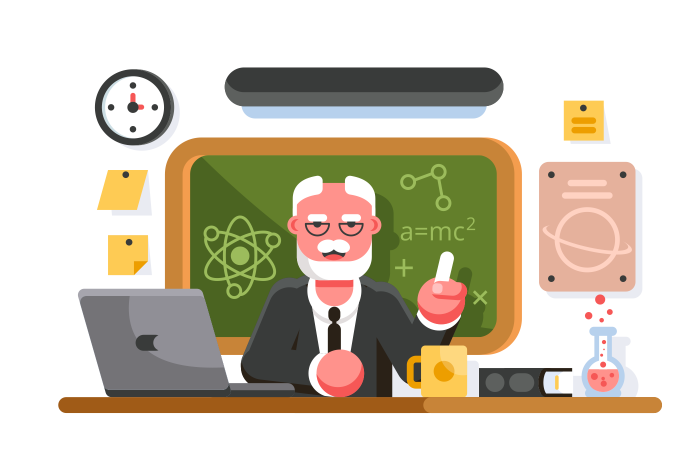The Halogens -Halide Ions and their Reactions (A-Level Chemistry)
Halide Ions and their Reactions
Reducing Power of Halides
Trends in Reducing Power
- As you move down the group, the reducing power of the halides increases. As a reducing agent, a halide ion loses an outermost electron and the ability to lose this electron depends on the shielding effect and the ionic radius. The greater the reducing power of a halide, the more easily it can lose electrons.
- As you move down the group of halides, the attraction between the nucleus and the outer electrons decreases. The attraction between the outermost electrons the the positive nucleus weakens as the ionic radius increases. This means that the distance between the outer electrons and the nucleus increases. Additionally there is a greater shielding effect as more inner electron shells are present which also weakens the attraction.
- The reaction of halides with sulphuric acid can be used to compare the reducing power of the halides. When halides react with concentrated sulphuric acid, a hydrogen halide is produced as an initial product. Other products can also be produced depending on the halides.

Reaction with Sulphuric Acid
You should be learn the following different reactions of sodium halides with sulphuric acid:
1. Reaction of NaF or NaCl with H2SO4:
Hydrogen fluoride or hydrogen chloride gas is formed depending on which halide is used. You can identify these substances as misty fumes when the gas contacts the moisture in the air.

The reaction does not proceed after this as HF and HCl are weak reducing agents. They are not strong enough to reduce sulphuric acid.
This is not a redox reaction as the oxidation states of halide and sulphur do not change.
2. Reaction of NaBr with H2SO4:
Hydrogen bromide gas is formed in the first reaction as observed by the misty fumes.

However in this case, the reaction does proceed after this as HBr is a strong enough reducing agent so it reacts with H2SO4 in a redox reaction:

Sulfur dioxide gas is produced as choking fumes as well as bromine gas as orange fumes.
3. Reaction of NaI with H2SO4:
The first two reactions are the same as before. Hydrogen iodide is formed and can be observed as misty fumes.

Hydrogen iodide then reduces sulphuric acid because it is a strong reducing agent.

However this time as hydrogen iodide is an even stronger reducing agent, it further reduces to SO2 to H2S. Solid iodine is also formed.

H2S is a toxic gas with a bad eggy smell.
Testing for Halides
Using Acidified Silver Nitrate Solution
- Acidified silver nitrate solution can be used to identify and distinguish between halide ions. Silver nitrate solution must be acidified using dilute nitric acid first as this removes any excess ions present in the solution that might react and affect the results.
- A precipitate of the silver halide will form when silver nitrate solution is added. The colour of the precipitate will help you identify the halide ion present. The table below summarises the different coloured precipitates and their associated halides. The precipitate of silver chloride forms the slowest and the precipitate of silver iodide forms the fastest.

Using Ammonia
- Ammonia solution is added to the precipitate to be certain of the identification of the halide. Different silver halides have different solubilities in ammonia, therefore you can use ammonia to distinguish between the halides. The table below shows the solubilities of the silver halides in ammonia. Silver chloride is the most soluble in ammonia and silver iodide is the least soluble.

Halogens are a group of non-metal elements found in the 17th group of the periodic table. They are characterized by their ability to form negative ions, known as halide ions, through the gain of one electron.
Halide ions are negative ions formed by the halogen elements. They have a charge of -1 and are composed of a halogen atom and an extra electron. Examples of halide ions include chloride (Cl-), bromide (Br-), and iodide (I-).
Halogens are highly reactive elements and form compounds with other elements through a series of chemical reactions. They are known for their strong oxidizing properties, meaning they can readily gain electrons to form halide ions.
Halogens react with metals to form halide salts through a process called displacement. In this process, the metal loses electrons to the halogen, which gains electrons to form a halide ion. The metal cation and halide ion then combine to form a salt.
Halide salts have a variety of physical properties, including solubility in water, melting and boiling points, and crystal structure. Some halide salts, such as sodium chloride (NaCl), are highly soluble in water, while others, such as silver chloride (AgCl), are sparingly soluble.
Halide salts react with acids to form hydrogen halides, which are strong acids. The reaction between a halide salt and an acid is an exothermic reaction, meaning it releases energy in the form of heat.
The properties of a halide salt can be affected by changing the halide ion. For example, halide salts with larger halide ions, such as iodide, are generally more soluble in water than halide salts with smaller halide ions, such as chloride. Additionally, the melting and boiling points of halide salts can be affected by the size of the halide ion.
Halogens and halide ions play a significant role in many aspects of everyday life. They are used in a variety of applications, including water treatment, food preservation, and the production of household and industrial chemicals. Additionally, halogens are essential for human health and are found in many essential vitamins and minerals.






Still got a question? Leave a comment
Leave a comment